
It wasn’t in the middle of a farmer’s muddy field or deep in the boreal forest where the Canadian oilsands truly struck pay dirt.
It was inside Fort McMurray’s recreation centre.
More than 1,400 oilpatch workers, corporate executives, provincial leaders and the country’s prime minister assembled 21 years ago in northern Alberta to grasp a brass ring of opportunity, pledging to “realize the potential of the oilsands opportunity for the benefit of all Canadians.”
On June 3, 1996, Canada’s Declaration of Opportunity for the oilsands was signed, kicking off an unprecedented era of expansion for the world’s third-largest oil reserves.
“This was a nation-building project,” says Eric Newell, who attended the event as head of Syncrude Canada. “We needed to all pull together.”
At that time, the oilsands had been led by two pioneering mining projects — Syncrude and Suncor Energy — that had begun with a bold vision, but struggled mightily to finally become profitable.
Investors, however, still weren’t knocking at the door.
Jean Chretien gives the thumbs up to supporters in this file photo from 1996.
The signed declaration would change the trajectory, laying bare the country’s ambitious goals for the future. It predicted 19 new oilsands projects would be built by the year 2020, attracting $25 billion in investment and creating 44,000 jobs.
With a new uniform royalty rate in place by the Alberta government, and tax changes adopted by Ottawa, daily oilsands production was projected to nearly triple to 1.2 million barrels.
Privately, many thought the target was too grand.
But the crowd inside the centre, including prime minister Jean Chretien, were about to unleash an unprecedented boom for Canada’s energy industry.
Production soared from 445,000 barrels per day in 1996 to top 2.4 million barrels per day last year. It’s expected to hit three million a day by the end of this decade — fully 150 per cent above initial targets.
Capital investment in the oilsands soared to an eye-popping $262 billion from 1996 until 2015. Another $190 billion was spent on operations.
Royalty payments to governments topped $38 billion.
“It worked far better than I had ever envisioned and brought in revenues that were far, far beyond what we ever expected,” says Pat Nelson, who attended the signing as Alberta’s energy minister.
“People were coming from all parts of the country and overseas to be part of the development that was taking place in Alberta.”
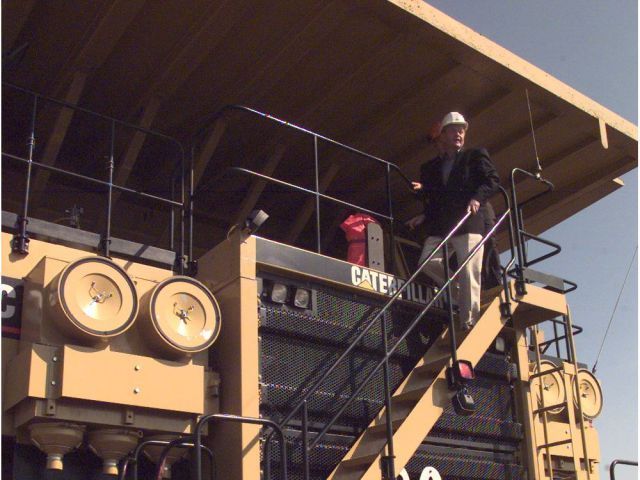
Jean Chretien stands high up on one of 23 Caterpillar trucks in use as part of the Syncrude 21 Mobile equipment in this file photo from 1996.
Investment soon brought jobs, drawing skilled workers from across the country; thousands moved to the province, while Alberta’s population surged to 4.3 million from 2.6 million.
A report by energy consultancy IHS Markit estimated 478,000 jobs — or three per cent of every job in the country — were tied to the oilsands’ boom by 2012. That was more than 10 times higher than the declaration’s target.
Armed with its oilsands bounty, Canada catapulted into position as the world’s fifth-largest oil producer, ahead of OPEC kingpins like Iraq, Kuwait and Venezuela.
“For years and years and years, the oilsands was regarded just as this fringe,” says Daniel Yergin, a Pulitzer Prize winning author and world-renowned energy analyst with IHS.
“It crossed the divide from being fringe to being a baseload (supply) and it changed the logistical dynamics of North America. It’s a major addition to North American and really global energy security.”
For Newell, the announcement marked the culmination of several years of arduous work, including chairing a national oilsands task force when the sector was on its heels in the early 1990s.
“Up until that time, everyone had this megaproject mentality. These projects were so big and so complex … that they needed government handouts or equity,” he says.
Government policy changes moved the oilsands into a new direction. Instead of having each project negotiate its own royalty deals, Alberta’s new generic regime, along with the accelerated writeoff of costs by the federal government, were designed to give investors certainty, helping offset the large investment risks.
Critics later saw it as a giveaway.

Jean Chretien salutes with his fists signifying the signing of the Declaration of Opportunity in this file photo from 1996. Behind him are Anne McLellan(red) and Pat Black.
“No longer would governments be overseers and financial partners, they would be mere facilitators, removing obstacles on the road to development,” says the 2017 report Betting on Bitumen for the Parkland Institute and Canadian Centre for Policy Alternatives.
The key for political leaders, however, was that the declaration didn’t focus only on what the changes would mean for the energy sector, but what it would mean for jobs.
Anne McLellan, the federal Natural Resources minister who attended the event, remembers it took some persuading of finance officials to sign on to the suite of changes, but it paid off.
“People forget that it wasn’t clear what the future — if any — the oilsands would have,” she says. “None of us understood the true potential of the resource.”
The declaration set the foundation for an explosive period of expansion.
Through a period of low oil prices in the late 1990s, to the post-911 push for security of supply, to crude topping $100 a barrel and the Great Recession, one constant remained: the oilsands were open for business.
Few places in the world offered such an opportunity with mammoth reserves, an open investment policy and stable rule of law.

Pulitzer Prize winner Daniel Yergin.
“What always, of course, kept people focused was a sense of virtual inexhaustibility,” says Yergin. “It’s not going to run out.”
People across the sector believe a combination of factors — high oil prices, attractive rules for investors, and new technology to access bitumen deposits too deep to mine — all coincided to usher in the largest industrial boom in modern Canadian history.
In the run-up to the day, however, the industry needed to improve its reliability and become more efficient.
The two oilsands miners moved away from bucket wheels, draglines and conveyor systems in the 1990s, turning to gigantic trucks and shovels to improve capacity. They opened up remote mines to boost production while using existing infrastructure.
Jim Carter, Syncrude’s chief operating officer who later became the president, remembers by the mid-1990s, the development increased throughput capacity to 74 million barrels a year from 54 million in 1989. At the same time, operating costs dropped from $18 to $12.50 per barrel.
Suncor also underwent major changes, with CEO Rick George making a concerted effort in the 1990s to squeeze out costs.
Former Suncor vice-president Dee Parkinson-Marcoux recalls she was hired to take over the oilsands operations and grind 25 cents out of each per-barrel cost, but it soon became obvious that wouldn’t be enough.
Instead, she pushed for a sweeping program to replace the bucket wheels with trucks and shovels in the early 1990s, among other changes, taking out about $5 a barrel in permanent costs.
“People were so married to the bucket wheel. They’d say, ‘It’s in our logos,’” she recalls. “We had to rethink how we ran the whole plant.”

Greg Stringham
For the sector, the biggest shift came in the development of technology needed to access the 80 per cent of the bitumen bounty that was buried too deep underground to mine.
Multiple companies, government agencies and researchers toiled for years to develop steam-assisted gravity drainage, a process that injects steam underground to warm up the molasses-like bitumen so it can be recovered through wells.
“That was really the key that unlocked the rest of it,” says Greg Stringham, a former Alberta Energy Department executive who later became vice-president of oilsands for the Canadian Association of Petroleum Producers.
“That technology was really the turning point that hit by the early 2000s.”
Origins of the oilsands
Compiled by Norma Marr
Sources: Calgary Herald Archives; Postmedia Archives; Government of Alberta; Steward: 75 Years of Alberta Energy Regulation (Gordon Jaremko)
With new rules and technology, a tsunami of investment started to flood into the sector.
Expansions took place at both Syncrude and Suncor. In the late 1990s, Shell Canada gave the green light to the Athabasca oilsands project, giving Alberta its third oilsands mine — and its first new one in two decades, backed by a major multinational oil producer.
The company, majority owned by international giant Royal Dutch Shell Group based in The Hague, had acquired one of the prime oilsands leases back in the late 1950s and was facing provincial government pressure to use it or lose it.
“This was Shell’s third attempt to fire the starting pistol on its oilsands project,” says Tim Faithfull, CEO of Shell Canada at the time and now a director with Canadian Natural Resources.
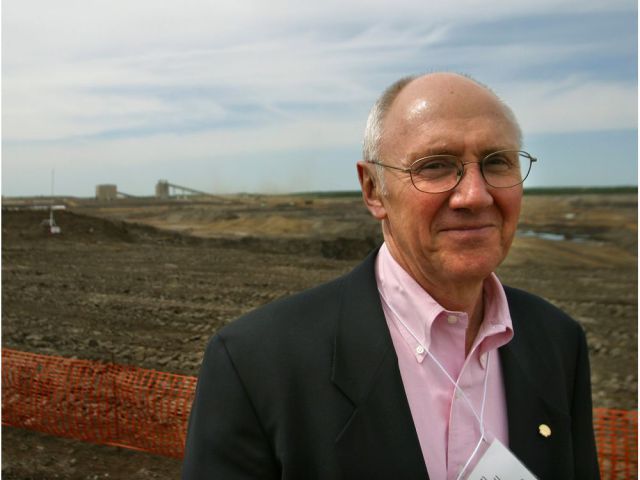
Tim Faithfull stands in front of theMuskeg River Mine during a tour of the project in Fort McMurray in this historical photo.
While the lease contained at least six billion of barrels of reserves, the project was looking at single-digit returns, he says.
At the time, Royal Dutch Shell was also wary about growing environmental issues, such as concerns about greenhouse gas emissions and the potential impact of nearby First Nations communities.
“It was a difficult decision. The Shell group thought long and hard about it,” he said.
Neil Camarta, a northern Alberta native who had joined Shell Canada, was put in charge of strategic planning and given the job to develop the project.
“What motivated big oil companies were reserves in the ground. Shell didn’t want to see (the lease) turned back to the government,” he says.
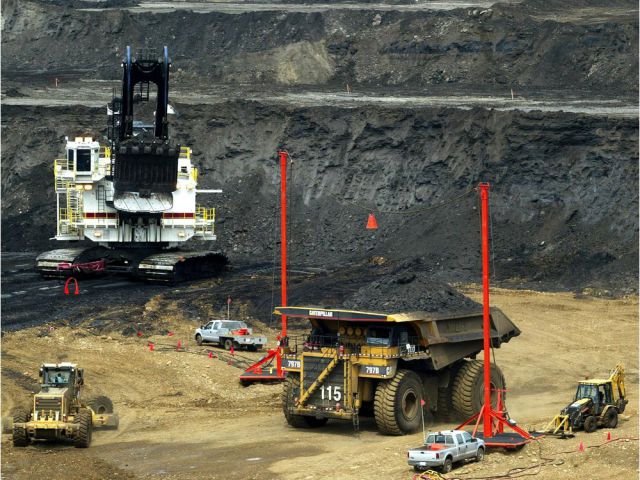
A rock truck pulls away from the shovel with a full load from the Muskeg River Mine in Fort McMurray in this historical photo.
The timing looked tenuous early on.
Oil prices collapsed to US$10-a-barrel range in late 1998. Shell lost its mining partners in the project the following spring, replacing them and sanctioning the venture in December 1999.
As construction began, international oil prices began to rebound, topping $25 a barrel by the start of new millennium. This upswing ushered in another problem that would soon spread across the sector: escalating costs.
Shell’s capital expenses shot up 50 per cent to almost $6 billion, amid rising labour expenses and lower-than-expected productivity.
“The biggest problems were the cost overruns and I remember plenty of trips to The Hague to explain them,” recalls Camarta.
“The price run-up saved my bacon.”
Other companies soon followed, with much of the investment flowing into underground “in-situ” thermal projects, such as Encana’s Foster Creek development, which began in 2001; it produced 166,000 barrels per day for Cenovus Energy last June.
Since 2008, in-situ production has jumped 143 per cent to 1.4 million barrels per day, eclipsing oilsands mining output.
Related
As thermal projects gained popularity, oil hit $100 a barrel in early 2008, and topped $147 by July of that year.
The boom was on.
“Everybody decided to get into the business then. A lot of people who had never thought of the oilsands were now coming to the party,” says Carter, president of Syncrude Canada until 2007.
“The quality of work went down, the productivity went down and the costs went up.”
When the massive size of the reserves were formally recognized by governments and energy agencies around the world — total reserves were pegged at 165 billion barrels last year — more multinationals wanted in.
In 2005, companies paid out $388 million to the province for oilsands leases. The next year, the number ballooned to almost $2 billion.
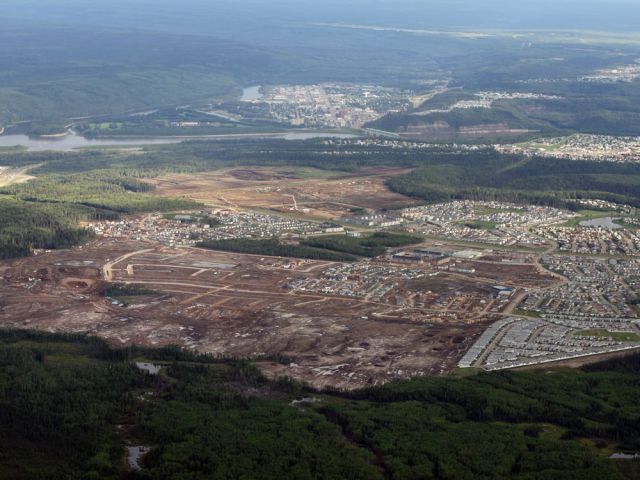
An aerial photo taken in 2006 shows the rapid growth of Fort McMurray, with the Athabasca River and the original lower townsite of McMurray in the centre background.
A National Energy Board report that year noted the number of major mining, upgrading and thermal oilsands projects had risen to include 46 existing and proposed developments.
With massive growth came major pressure, from rising labour shortages and sprawling work camps in the region to soaring housing expenses in Fort McMurray.
In September 2006, former premier Peter Lougheed described the oilsands development as a “mess.”
Some First Nations groups and environmental critics complained to government about the cumulative effects of the boom on land, air and water in the region.
“At the time, we saw what was a gold rush mentality and were concerned about a lack of planning,” says Simon Dyer, who was then oilsands program director for the Pembina Institute and remains with the Alberta-based environmental think-tank.
“We maximized the oilsands, we never optimized the oilsands, and that’s something worth reflecting on.”
By the mid-2010s, as more production and projects moved ahead, the oilsands industry was facing a concerted global PR campaign and an array of critics to halt its expansion, from former U.S. vice-president Al Gore to celebrities like Hollywood director James Cameron.
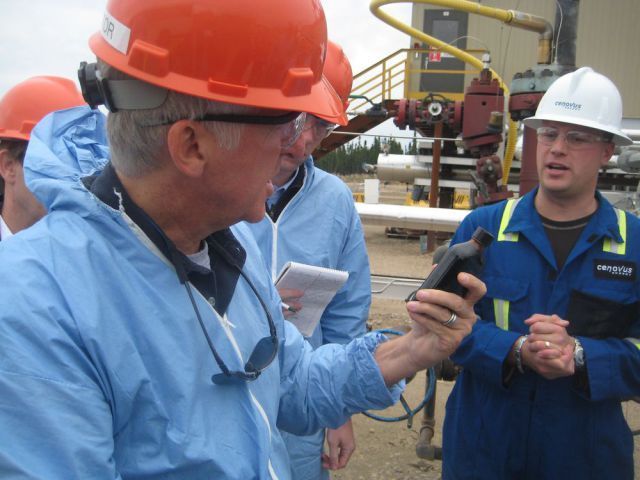
Director James Cameron (L) examines a sample of the oil drained using underground steam technology at Cenovus’s Christina Lakes in situ oilsands project in this file photo from 2010.
“It’s a vast resource, but it was used more as a symbol,” says Joe Oliver, who became federal Natural Resources Minister in the Harper government in 2011.
“They just wanted to stop the development of oil and gas and the oilsands … were a convenient target.”
Through it all, production kept growing.
In 18 years, oilsands output increased almost five-fold, “an amazing achievement,” says Yergin.
The draw of foreign investment, the sweeping economic benefits that reached across the country, and talk by Prime Minister Stephen Harper that Canada was becoming an energy superpower, sparked other political debates.
The impact on Canada’s greenhouse gas emissions, the role of pipelines, and limitations put on investments by state-owned enterprises spun out of the oilsands boom.
A brief shutdown of the oilsands last spring because of wildfires around Fort McMurray illustrated the burgeoning economic clout of the sector, chopping the entire country’s GDP outlook by almost a half-percentage point in the second quarter of 2016.
Since 2014, the collapse of global oil prices and retreat of international companies have shifted the oilsands into a new phase, one with more moderate growth on the horizon.
But there’s little doubt the era of expansion left an indelible impression on the global energy sector, the province and the entire country.
“I don’t think anybody could have predicted what would happen,” said Carter, who was at the Fort McMurray announcement 21 years ago.
“It really did take off. All of the stars in the constellation were really aligned.”
.com
You can read more of the news on source
